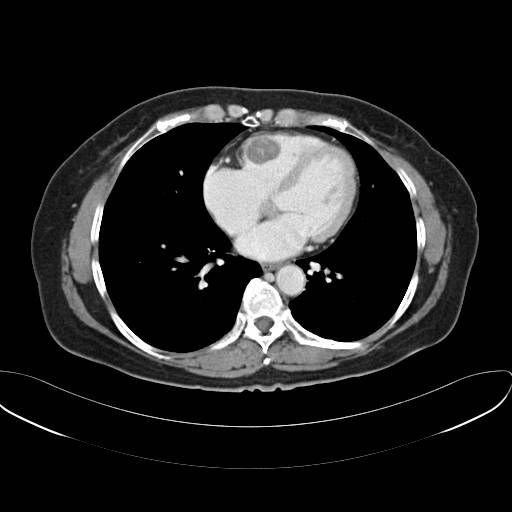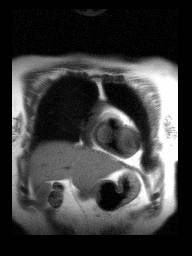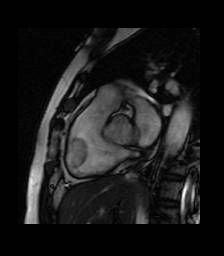Cardiac Hemangioma
A 55-year-old female found to have a cardiac mass during evaluation of dizziness. Cardiac CT showed lesion of soft tissue density confined in right atrium.
Clinical history: A 55-year-old female found to have a cardiac mass during evaluation of dizziness.

Figure 1: Chest CT

Figure 2: Coronal T1-weighted image

Figure 3: Coronal T1+C

Figure 4: Oblique gradient-echo cine image
Findings: Her cardiac CT showed one space-taking lesion of soft tissue density confined in right atrium, without extension into adjacent organ. Cardiac MRI showed one well-defined intra-cardiac mass in right atrium attaching to myocardium. The tumor showed intermediate to bright on T1- and T2-weighted images and enhancement after Gd-DTPA administration.
Diagnosis: Cardiac hemangioma
Discussion: The most frequent mass within a cardiac chamber is thrombus. The overall frequency of cardiac tumor is 0.15 percent in echocardiographic series. Of all cardiac tumors, primary tumors are rare, while secondary tumors are about 40 times more frequent than primary cardiac tumors.
Cardiac hemangiomas are composed of endothelial cells that line interconnecting vascular channels. They are usually asymptomatic when diagnosed after infancy, and the commonest presentation is dyspnea on exertion if symptomatic.
Imaging findings: Cardiac hemangiomas may involve the endocardium, myocardium, or epicardium. They can arise from all chambers and also pericardium. On T1-weighted images, hemangiomas are intermediate to hyperintense. On T2-weighted images, they are hyperintense to myocardium. After Gd-DTPA administration, they usually have rapid enhancement during first-pass Gd contrast infusion because of their high vascularity, and usually show intense but inhomogeneous enhancement
Differential diagnosis: There are some methods to differentiate between thrombus and tumor on medical images. A thrombus shows low signal intensity on gradient-echo images, while tumors are hyperintense to myocardium. However, exceptions to this generalization are fresh blood clot can have high signal intensity, and some myxomas containing iron produce low signal and mimic thrombus. Besides, thrombus does not enhance after the administration of Gd-DTPA, whereas tumors show enhancement.
About 80 percent of primary cardiac tumors are benign, including myxoma, lipoma, papillary fibroelastoma, rhabdomyoma, and hemangioma. Cardiac pheochromocytoma is also reported and is very rare. Myxoma is the most common benign cardiac tumor. Myxoma is dumbbell shape, and is usually mobile with its shape varied during cardiac cycle.
One-fourth of primary cardiac tumors are malignant, with sarcomas being the most common, followed by primary cardiac lymphomas. There are features indicating malignancy of a primary cardiac tumor on medical images, including involvement of more than 1 cardiac chamber, wide point of attachment to the wall, necrosis within the tumor, extension outside the heart, and hemorrhagic pericardial effusion. Other signs of malignancy include intramural and intracavitary location, extension into the mediastinum, and rapid growth.
Conclusion: Cardiac hemangioma is a rare benign tumor of the heart. The differentiation of this benign tumor from the malignant types is essential in planning subsequent management. Cardiac MRI is a valuable tool to differentiate this tumor from other benign and malignant tumors.
References:
1. Sutsch G, et al: echocardiographies. Schweiz Med Wochenschr 1991;121:621-62
2. Markel ML, Waller BF, Armstrong WF. Cardiac myxoma: a review. Medicine (Baltimore) 1987;66:114-25.
3. Oshima H. et al: J Thorac Imaging 2003;18:204-6.
4. Stephane Moniotte, et al: Cardiac hemangioma. Circulation 2005, 112:e103-e104
5. Ahmed Alsaileek, et al: Diagnostic features of cardiac hemangioma on cardiovascular magnetic resonance, a case report. The International Journal of Cardiovascular Imaging 2006: 699-702.
Chih-Chun Wu, MD, radiologist in Medical Imaging Department, Cheng Hsin General Hospital, Taipei, Taiwan
Can CT-Based AI Radiomics Enhance Prediction of Recurrence-Free Survival for Non-Metastatic ccRCC?
April 14th 2025In comparison to a model based on clinicopathological risk factors, a CT radiomics-based machine learning model offered greater than a 10 percent higher AUC for predicting five-year recurrence-free survival in patients with non-metastatic clear cell renal cell carcinoma (ccRCC).
The Reading Room Podcast: Current Perspectives on the Updated Appropriate Use Criteria for Brain PET
March 18th 2025In a new podcast, Satoshi Minoshima, M.D., Ph.D., and James Williams, Ph.D., share their insights on the recently updated appropriate use criteria for amyloid PET and tau PET in patients with mild cognitive impairment.
Could Lymph Node Distribution Patterns on CT Improve Staging for Colon Cancer?
April 11th 2025For patients with microsatellite instability-high colon cancer, distribution-based clinical lymph node staging (dCN) with computed tomography (CT) offered nearly double the accuracy rate of clinical lymph node staging in a recent study.
Could Ultrafast MRI Enhance Detection of Malignant Foci for Breast Cancer?
April 10th 2025In a new study involving over 120 women, nearly two-thirds of whom had a family history of breast cancer, ultrafast MRI findings revealed a 5 percent increase in malignancy risk for each second increase in the difference between lesion and background parenchymal enhancement (BPE) time to enhancement (TTE).
Study Suggests AI Software May Offer Standalone Value for X-Ray Detection of Pediatric Fractures
April 9th 2025Artificial intelligence (AI) software demonstrated a 92 percent sensitivity for detecting fractures in a study involving over 1,600 X-rays from a tertiary pediatric emergency department.